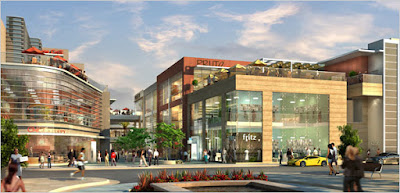1:10 PM | Boyle Heights, East LA, Eastside, Echo Park, gentrification, LA Times, Silver Lake, Westside
 The long-fought battle over the definition of LA's Eastside gained new interest today, thanks to an LA Times article by Esmeralda Bermudez. Residents of neighborhoods like Boyle Heights, just east of Downtown, claim the Eastside has always been defined as the area of the city east of the LA River. The term 'Eastside,' originally used pejoratively by politicians before the 1960s, carries with it a history of racial discrimination and Chicano pride. It was a name thrust on area Latinos by wealthy white Westsiders, and it stuck.
The long-fought battle over the definition of LA's Eastside gained new interest today, thanks to an LA Times article by Esmeralda Bermudez. Residents of neighborhoods like Boyle Heights, just east of Downtown, claim the Eastside has always been defined as the area of the city east of the LA River. The term 'Eastside,' originally used pejoratively by politicians before the 1960s, carries with it a history of racial discrimination and Chicano pride. It was a name thrust on area Latinos by wealthy white Westsiders, and it stuck.
But another group has begun to adopt the name for their own part of the city - an area on the other side of town. New residents in neighborhoods like Silver Lake and Echo Park have picked up the name as a cultural backlash against the pricey real estate and superiority complex of the Westside. These Eastside "pretenders" are young, middle to upper-middle class whites, often hailing from out-of-state, with little knowledge of the city's geography and cultural history. They are the arbiters who have contributed to the gentrification of places like Echo Park, a neighborhood that was for a long time poor and predominantly Mexican-American.
A year ago, a number of activists associated with the blog LAeastside.com, tagged posters all over areas considered to be the Eastside "sham," like one on the bus stop above. (If you look closely, you can identify Intelligentsia - the Silver Lake hipster Mecca - in the background.) Defenders of the east-of-the-river title claim that the usage of the label by outsiders is ignorant and "eliminates us." One victory this group claims is the renaming of the Eastside Art Crawl to the Silver Lake Art Crawl. But many west-of-the-river advocates argue they are not trying to supplant any one's cultural history - they are merely creating an identity for themselves that rejects the white picket fence idyll of West LA.
It is a sticky issue that is not new to a city where boundaries are both ever-present and blurry. It is, like many topics in LA, an issue that is both racial and political at its roots. As a state that was annexed by the US from Mexico, California has a deep history of supplanting and removal, especially of Mexicans. Latino Americans fought hard in the 1960s for equality at schools and in the workplace. Boyle Heights and unincorporated East LA boast a rich history of Mexican-American-ness that is both proud and dark. Silver Lake yuppies would be wise to invent an identification that both celebrates their values and doesn't devalue those of another. But heated political debates aside, look at the pure geography - can something really be considered "east" if it lies significantly west of the city's center?
















